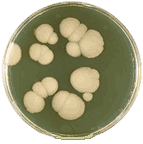Papers in the Biological Sciences
Date of this Version
1999
Document Type
Article
Citation
Published in Virology 263 (1999), pp 254−262.
Abstract
Sequence analysis of the 330-kb genome of chlorella virus Paramecium bursaria chlorella virus 1 (PBCV-1) revealed an open reading frame, A237R, that encodes a protein with 34% amino acid identity to homospermidine synthase from Rhodopseudomonas viridis. Expression of the a237r gene product in Escherichia coli established that the recombinant enzyme catalyzes the NAD+-dependent formation of homospermidine from two molecules of putrescine. The a237r gene is expressed late in PBCV-1 infection. Both uninfected and PBCV-1-infected chlorella, as well as PBCV-1 virions, contain homospermidine, along with the more common polyamines putrescine, spermidine, and cadaverine. The total number of polyamine molecules per virion (~539) is too small to significantly neutralize the virus double-stranded DNA (>660,000 nucleotides). Consequently, the biological significance of the homospermidine synthase gene is unknown. However, the gene is widespread among the chlorella viruses. To our knowledge, this is the first report of a virus encoding an enzyme involved in polyamine biosynthesis.
Included in
Environmental Microbiology and Microbial Ecology Commons, Other Life Sciences Commons, Pathogenic Microbiology Commons


Comments
Copyright © 1999 by Academic Press. Used by permission.